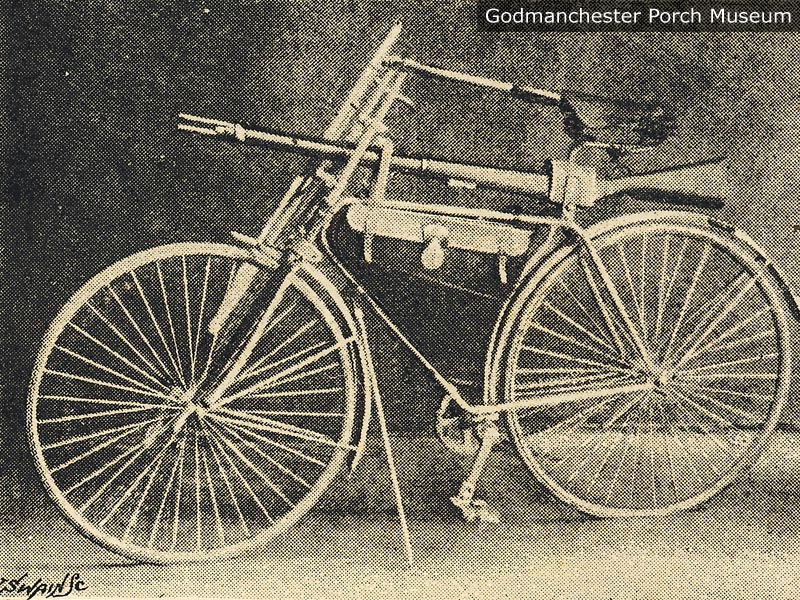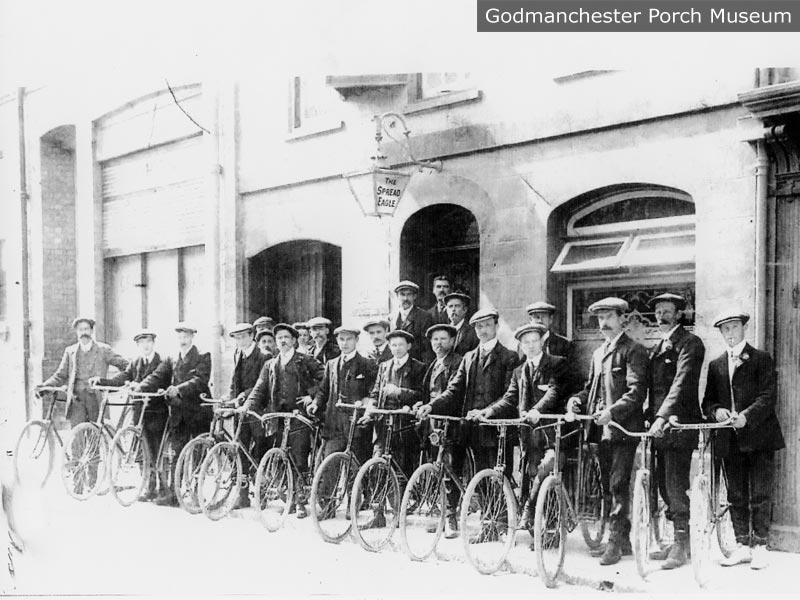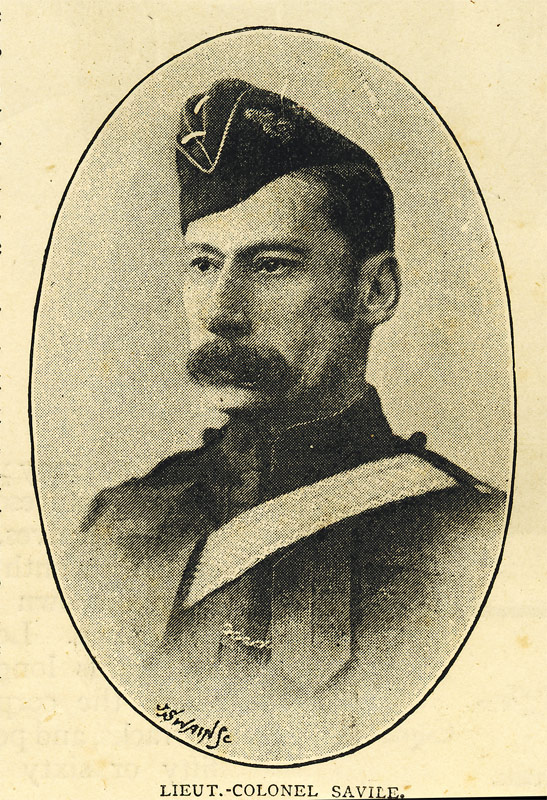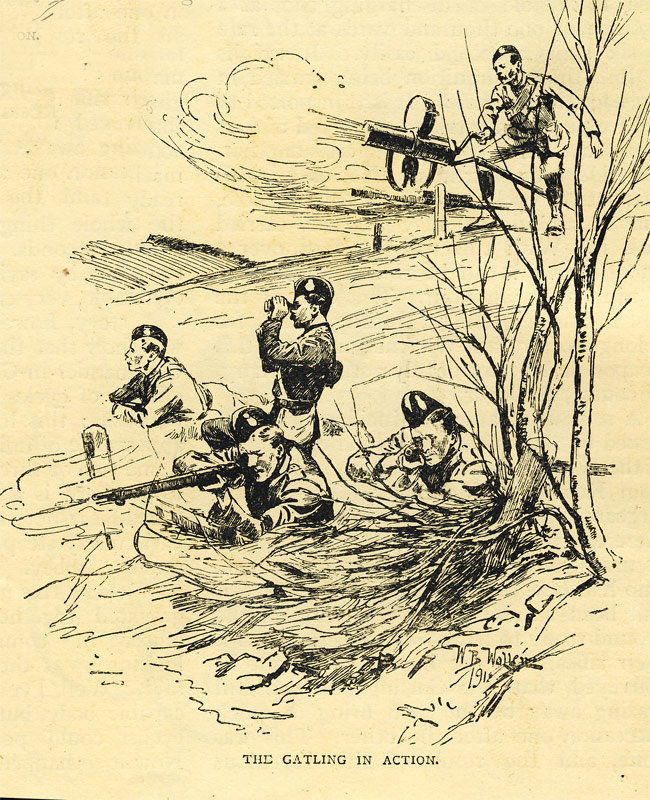Page 2 of 2
So clever are they at forming these cycling squares, so to speak, that the whole thing can be accomplished Cyclists Gun in some five or six seconds. Indeed, taken all round, the military cyclist is not only a very ingenious fellow, but a good way ahead of the ordinary infantry men; in fact, he is really an infantry man on temporary wheels; for, when engaged in fighting, he dismounts from his machine, places his cycle on the ground, or hides it in a hedge, and combats on foot. We have spoken of the ingenuity of the cyclist.
Cyclists Gun in some five or six seconds. Indeed, taken all round, the military cyclist is not only a very ingenious fellow, but a good way ahead of the ordinary infantry men; in fact, he is really an infantry man on temporary wheels; for, when engaged in fighting, he dismounts from his machine, places his cycle on the ground, or hides it in a hedge, and combats on foot. We have spoken of the ingenuity of the cyclist.
The Writer of this article went to Dover last Easter for the purpose of following this regiment on Wheels, in order to see what practical use they would be in time of warfare. Had it not been for the cyclists, the bridge over the railway at Lydden which communicated with London would have been blown up, and all further supplies to the besieged town stopped. This was no doubt due to the fact that the men on their bicycles under command of Captain Holmes were able to reach the spot which the enemy desired, whereas had infantry men been singled out for the task, they would have been too late, and the enemy already _in possession.
Not the least interesting Weapon carried by the cyclists, and used for the first time at the Easter manoeuvres, is the Gatling gun. This particular gun used is capable of discharging shot at a distance of one thousand yards at the rate of six shots a second easily. It weighs 97 lbs., the ammunition being carried in cases for the purpose. It is transported to and fro on a gun-carriage composed of four safety machines coupled to one another, and ridden by four men. Not only is this quartette of cycles useful for this purpose, but an ambulance may also be carried with it. With this weighty load, over a smooth road, it can be ridden at the rate of nine miles an hour. This idea of the best means of getting a Gatling to and fro belongs to Sergeant Watkins, and with this Weapon he did some deadly Work (imaginary, of course) at Dover.
A somewhat amusing incident was witnessed by the writer, who stood by the side of the Gatling on the hill some few miles from Kearsney, near Dover. The gallant sergeant found his ammunition exhausted; there was no more to be had. It suddenly occurred to the officer in charge of the men, who had now left the machines on which it had been carried, and were lying on the ground ready to let go at the enemy with their riffles , that the impression might be conveyed that the Gatling gun was still blazing away by the men firing in quick succession one after the other. This was done, and the result of this ingenious subterfuge was that many of the enemy imagined that they were still being annihilated by the murderous weapon.
 Hunts Cyclists Spread Eagle
Hunts Cyclists Spread Eagle
The Duke of Cambridge, who is a strong adherent of military cycling, singled out this regiment on wheels for his special approval at the late Easter manoeuvres. When he saw the Gatling gun on its carriage, he gave the command that the gun should at once be put into action. The men sprang from their machines, dismounted the gun, placed it ready for firing, took up their positions, the whole thing being accomplished in twenty seconds. 'The Duke encouraged the men by saying most heartily, "Very creditable, very creditable."
A story, however, may be told which will show that there was a time when our Commander-in-Chief had his doubts of the efficacy of cycles being adapted for military purposes this happened in 1887, the first appearance of military wheelmen at Dover.
Some two or three miles from the seaport town there is a picturesque little village called Keursney, and amongst its sights is a particularly steep hill leading to St. Radigund's Abbey. The Duke chanced to pass where the military cyclists were congregated together, and approaching the officer in command, good-humouredly looking up at the hill, his Royal Highness said, Well, I've no doubt your men are a capable body, but I question Whether any cyclist could possibly mount that hill-." Now it so happened that there was a very fast rider present, an exceptionally powerful man on wheels, Mr. M. D. Rucker. This little fact the commanding officer knew, and asked the Duke for permission to put his remarks to the test; this was readily granted, and away Mr. Rucker went on his machine, the Duke himself watching him for a considerable distance until at last he rode away himself. Some time passed by, when again the cyclist body found itself near to the Duke: once more riding up, he asked, "Is that man back yet?" when our smart cyclist immediately stepped up with a salute, and said, "Yes; sir, here I am." We are probably right in saying that this was the foundation of the Duke's faith in utilising cyclists for military purposes, as having sent a horseman with him, at the first six-barred gate, which was locked, the cyclist lifted his machine over, leaving the unfortunate "galloper " behind, his horse refusing to take the gate.
The important question now arises as to what advantage the propeller of the iron steed has over the ordinary rider on horseback. In the first place, we cannot do better than quote the estimate of the cost' of a mount of cavalry in proportion to that of cyclist infantry as compared by Captain Eustace Balfour, of the London Scottish, in a paper he contributed to Service Magazine twelve months ago. His estimates are as follow
CYCLIST INFANTRY. Lieut.-Colonel Saville
Lieut.-Colonel Saville
- Cost of cycle per man, £12.
- A .Life of cycle (say six years), therefore cost per annum, £2.
- Repairs, oil, &c., say £1.
- Total cost per annum, £3.
CAVALRY.
- Cost of horse, £35.
- Useful' life (say seven years), therefore cost per? annum, £5.
- Maintenance, 40.
- Total cost per annum, £45
It will at once 'be that the cyclist by a long cheaper of the two.
Again, the machines are more easily conveyed by rail, as many could be stacked in the space occupied by a single horse. On the score of staying power, it is calculated that a man could ride a cycle thirty miles and be just as fit for marching as an infantryman would be, fresh to the task, without having had the benefit of the thirty miles' start. Machines, too, are noiseless; but what strikes us as the greatest advantage of all is the fact that cyclists are able to ride along roads unseen, Whereas a cavalryman traversing the same path would be immediately spotted, on account of the dust his horse's hoofs would raise on a dry day.
A man on his machine, by bending over the handles somewhat, is really able to make himself shorter than the ordinary foot soldier; he still keeps on his Way, being covered by the hedges, and the chances are that he will arrive at his destination with a far greater amount of certainty than the man on horseback.
The principal duties which the cyclists have to perform are those of carrying despatches, skirmishing, and reconnoitring. Owing to the long distance which they are able to cover in a short space of time, they are likely to prove very successful in the Way of making, sketches of the surrounding country, reporting on the probability of provisions, the state of the roads, railways, rivers, and canals, the situation of fortified places, indeed, all the thousand and one items of observation which constitute reconnoitring duties. As patrols they are unquestionably useful, and a capital example is that afforded by the ingenuity of a number of cyclists who cleverly managed to get through the enemy's lines and gain the required information as to what was their strength. This force was told off to get through the lines at any cost.
Our heroes of the wheel, seeing a waggon filled with straw passing along the road, induced the driver for a consideration to let them take shelter with their machines underneath the straw; this he agreed to do, and by this means they got through the outpost line, did their spying, and returned in perfect safety the same way that they Went.
 Gattling in action
Gattling in action
It is needless to say that the cyclists have to put up with a fair share of good humoured chaff from their rival, the cavalryman, but the horseman is beginning to recognise the fact that his brother rider is becoming a substantial acquisition in matters military, and almost regards him with respect. Our regiment on wheels seems to be Wanting in only one thing - a band. Many suggestions of a decidedly humorous nature have already been made, the most likely of which is the idea of a member of the corps for a huge musical box, to be ridden in a similar style to that of a the Gatling gun on four machines.
He is of opinion that in this age of invention it should be possible to construct a musical machine in such a way that as the riders work the treadles so should the "bandbox " give forth martial strains to cheer the cyclist on as he went forth to meet the foe.